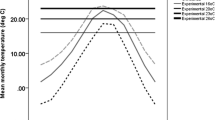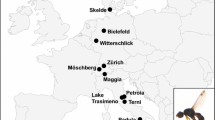Abstract
The correlation between body size and longevity was tested in an Argentinian natural population of Drosophila buzzatii. Mean thorax length of flies newly emerging from rotting cladodes of Opuntia vulgaris was significantly smaller than that of two samples of flies caught at baits. The present results which might be interpreted as directional selection for longevity favoring larger flies are in agreement with previous results achieved in a Spanish natural population of D. buzzatii. Flies emerging from different substrates showed significant differences in thorax length, suggesting that an important fraction of phenotypic variance can be attributed to environmental variability. However, laboratory and field work in different populations of D. buzzatii showed a significant genetic component for thorax length variation.
Similar content being viewed by others
References
BarkerJ. S. F., 1982. Population genetics of Opuntia breeding Drosophila in Australia, p. 209–224 in Ecological Genetics and Evolution, edited by J. S. F.Barker and W. T.Starmer. Academic Press, New York.
DavidJ. R., 1979. Utilization of morphological traits for the analysis of genetic variability in wild populations. Aquilo Ser. Zool. 20: 49–61.
HassonE., J. J.Fanara, C.Rodriguez, J. C.Vilardi, O. A.Reig & A.Fontdevila, 1992. The evolutionary history of Drosophila buzzatii. XXIV. Second chromosome inversions have different average effects on thorax length. Heredity 68: 557–563.
HassonE., H.Naveira & A.Fontdevila, 1992. The breeding sites of the Argentinian species of the Drosophila mulleri complex (subgenus, Drosophila-repleta group). Rev. Chilena de Historia Natural 65: 319–326.
HassonE., J. C.Vilardi, H.Naveira, J. J.Fanara, C.Rodriguez, O. A.Reig & A.Fontdevila, 1991. The evolutionary history of Drosophila buzzatii, XVI. Fitness components analysis in a natural original population from Argentine. J. evol. Biol. 4: 200–225.
LintsF. A. & C.Hoste, 1974. The Lansing effect revisited. I. Life span. Exp. Gerontol. 9: 51–69.
LintsF. A. & C.Hoste, 1977. The Lansing effect revisited. II. Cumulative and spontaneously reversible parental age effects on fecundity in Drosophila melanogaster. Evolution 31: 387–404.
PartridgeL., A.Hoffman & J. S.Jones, 1987. Male size and mating success in Drosophila melanogaster and Drosophila pseudoobscura under field conditions. Anim. Behav. 35: 468–476.
BanridgeL. & M.Farquar, 1981. Sexual activity refluces life span of male fruit flies. Nature 204: 580–582.
PartridgeL. & M.Farquar, 1983. Literime reproductive success of male fruit flies (Drosophila melanogaster) is related to their size. Anim. Behav. 31: 871–877.
ProutT. & J. S. F.Barker, 1980. Ecological aspects of the heritability of body size in Drosophila buzzatii. Genetics 123: 803–813.
RobertsonF. W., 1957a. Studies in quantitative inheritance. X. Genetic variation of ovary size in Drosophila. J. Genet. 55: 410–427.
RobertsonF. W., 1957b. Studies in quantitative inheritance. XI. Genetic and environmental correlation between body size and egg production in Drosophila melanogaster. J. Genet. 55: 428–443.
RobertsonF. W., 1987. Variation of body size within and between wild populations of Drosophila buzzatii. Genetica 72: 111–125.
RuizA., M.Santos, A.Barnadille, J.Quesada-Diaz, E.Hasson & A.Fontdevila, 1991. The evolutionary history of Drosophila buzzatii. XVIII. Genetic variance for body size in a natural population. Genetics 138: 739–750.
SantosM., A.Ruiz, A.Barbadilla, J.Quesada-Diaz, E.Hasson & A.Fontdevila, 1988. Larger flies mate more often in a natural population of Drosophila buzzatii. Heredity 61: 255–262.
SantosM., A.Ruiz, J.Quesada-Diaz, A.Barbadilla & A.Fontdevila, 1992. The evolutionary history of Drosophila buzzatii. XX. Positive phenotypic covariance between field fitness components and body size. J. evol. Biol. 5: 403–422.
TantawyA. O. & F. A.Rakha, 1964. Studies on natural populations of Drosophila. 4. Genetic variances of and correlations between four characters in Drosophila melanogaster and Drosophila simulans. Genetics 50: 1349–1355.
TantawyA. O. & M. O.Vetukhiv, 1960. Effects of size on fecundity, longevity and fertility in populations of Drosophila pseudoobscura. Am. Nat. 94: 395–403.
TaylorC. E. & B.Kekic, 1988. Sexual selection in a natural population of Drosophila melanogaster. Evolution 42: 197–199.
WattiauxJ. M., 1968. Cumulative parental age effects in Drosophila subobscura. Evolution 22: 406–421.
WillkinsonG. S., 1987. Equilibrium analysis of sexual selection in Drosophila melanogaster. Evolution 41: 11–21.
Author information
Authors and Affiliations
Rights and permissions
About this article
Cite this article
Hasson, E., Fanara, J.J., Rodriguez, C. et al. The evolutionary history of Drosophila buzzatii XXVII . Genetica 92, 61–65 (1993). https://doi.org/10.1007/BF00057508
Received:
Accepted:
Issue Date:
DOI: https://doi.org/10.1007/BF00057508




